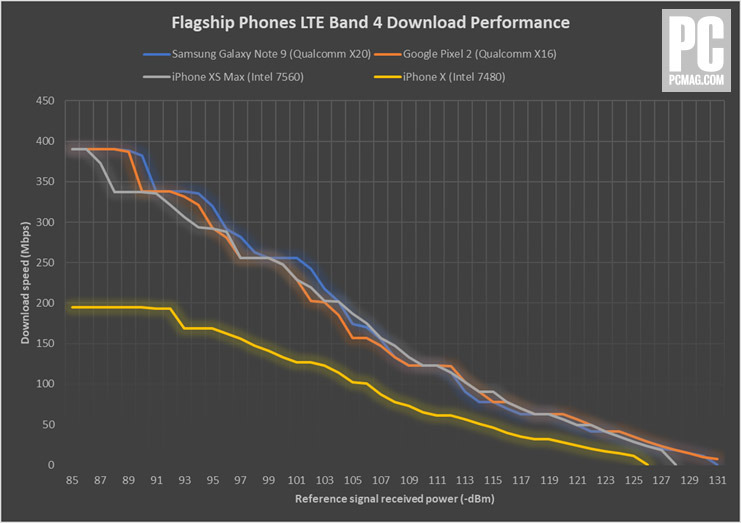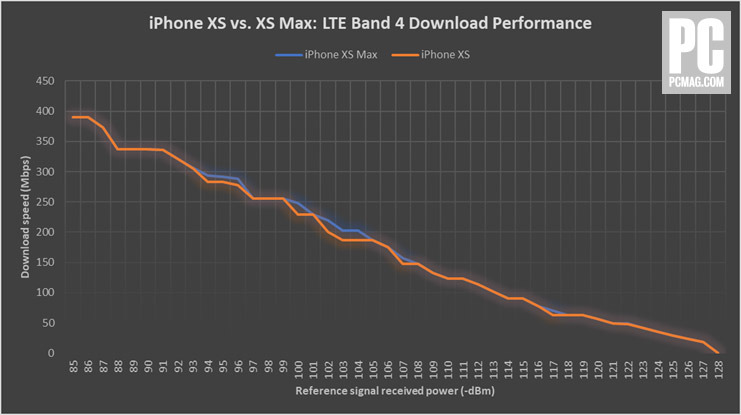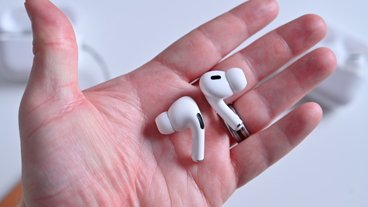Though a handful of early iPhone XS adopters are complaining about less-than-desirable cellular reception, a new test reveals Apple's latest flagship smartphones boast much improved LTE performance over last year's model. However, the XS models, which rely on Intel modems, are still behind handsets that use battle-tested Qualcomm silicon.
Conducted by PCMag in partnership with Cellular Insights, the evaluation pitted iPhone XS and XS Max against top industry performers including Samsung's Galaxy Note 9 and Google's Pixel 2. Last year's Intel-powered iPhone X, using the chipmaker's XMM7480 modem, was also included for reference.
For 2018, Apple opted to ditch Qualcomm in favor of Intel's next-generation XMM7560, an LTE modem capable of communicating with networks run by the four major U.S. wireless carriers. The latest iPhones are also the first to sport 4x4 MIMO antennas, boosting top-end speed and enhancing performance in areas where cell signals are weak.
Testing involved creating a 20MHz channel of Band 4, employed by AT&T, T-Mobile, Verizon and major Canadian carriers, with Rohde & Schwarz equipment capable of supporting 4x4 MIMO configurations. Cellular Insights attenuated an LTE signal from -85 dBm, a strong signal, and slowly decreased reference power until the phones ceased to download data.
Overall, iPhone XS Max performed nearly on par with the Galaxy Note 9 and Pixel 2, both of which sport Qualcomm modems in the X20 and X16, respectively. At -85 dBm, all three smartphones achieved nearly 400 Mbps download speeds. The XS exhibited a precipitous drop in performance at -86dBm, while the Pixel 2 and Note 9 saw nearly identical dips at -89 dBm and -90 dBm, respectively.
Apple's phone stopped receiving data at -128 dBm, while the Note 9 ceased reception at around -131 dBm. Interestingly, the Pixel 2's X16 modem continued to function beyond the measured range, though performance degraded to approximately 10 Mbps.
As can be expected from two nearly identical smartphones, Apple's XS and XS Max put in largely similar performances. The larger iPhone XS Max pulled ahead at certain signal levels, but the slight deviation would go unnoticed in a real-world scenario, the publication said.
Apple's latest iPhone, while trailing a bit behind competitors using Qualcomm modems, is markedly improved compared to it predecessor. Lab testing saw the iPhone XS Max handily outperform the iPhone X at all signal levels, nearly doubling the 2017 iPhone under good conditions. The gains are primarily attributed to 4x4 MIMO antennas, though fine tuning of Intel's new XMM chip seemingly helped iPhone XS Max perform with relatively weak signals.
Real-world testing bore similar results, with iPhone XS Max seeing an average download speed increase of 6.6Mbps on all U.S. carriers, according to statistics provided by speedtest specialist Ookla. AT&T was most improved with an 8Mbps bump in performance. In Canada, overall download average deltas jumped to 20.2Mbps, with Telus being the network most greatly benefitted from the changes Apple made this year.
Comparatively, Samsung's Note 9 displayed average LTE download speeds of 43.2Mbps during the week of Sept. 24, while iPhone speeds averaged 38.9Mbps for the same period. Again, download figures massively improved in Canada, where the Note 9 averaged speeds of 97.7Mbps to XS Max's 85.4Mbps, the study found.
Finally, the publication notes a bump in iPhone X performance when upgrading from iOS 11 to iOS 12. Notably, download speeds on an iPhone X running iOS 12 neared performance levels seen by Qualcomm versions of the device running iOS 11.
The test results arrive roughly one week after early iPhone XS and XS Max customers began to complain of poor cellular and Wi-Fi reception. Today's findings — lab tests in particular —
suggest Apple's hardware is not to blame, leaving hope that a firmware update will solve the sporadic issue.
 Mikey Campbell
Mikey Campbell





-xl-m.jpg)


-m.jpg)






 Thomas Sibilly
Thomas Sibilly
 Wesley Hilliard
Wesley Hilliard
 Christine McKee
Christine McKee
 Amber Neely
Amber Neely
 William Gallagher
William Gallagher
 Malcolm Owen
Malcolm Owen

 Mike Wuerthele
Mike Wuerthele







26 Comments
It's time Apple builds their own modems but wow looking at that graph you couldn't tell who's faster than who they're so close.
(for once) Intel should be commended for stepping up their game, as that’s quite a jump in performance from last year to this year
also, it would be interesting to compare the power requirements of each company’s modem
The difference is indeed negligible.
I stay stick with Intel as Intel can improve performance over time and even beat Qualcomm.
I hope other phone manufacturers switch to Intel as well.